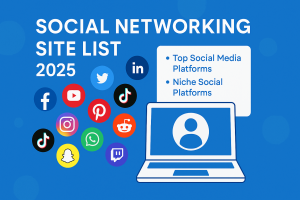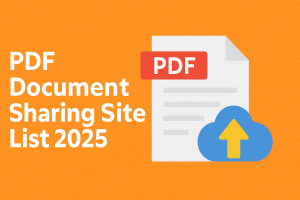Web 2.0 Sites List (2025): Safer, Smarter Backlinks You Control
Let’s be honest: a lot of people either ignore Web 2.0 links or use them badly. In 2025, the playbook is simple—treat Web 2.0s like small, real websites. When you do, they’re still a safe, flexible way to diversify your backlink profile, support new domains, and soften the blow from surprise updates. If you’re tired of “spin one post, drop a link” advice, you’ll like this guide. We’ll cover what works now, what trips filters, and how to build Web 2.0 properties that search engines actually trust.
Heads-up: this is about quality. A few strong, living profiles beat dozens of thin blogs every time.
What Are Web 2.0 Sites—and Why They Still Matter in 2025
Web 2.0 sites are free publishing platforms where you can create a small blog or site—think WordPress.com, Blogger, Tumblr, Medium, Weebly, and similar. These domains have long trust histories, clear moderation, and real users. When you create a public, useful profile or mini-site and link back to your brand, you’re building:
- Entity signals: consistent brand/name/URL across the web helps search engines “understand” you.
- Backlink diversity: not all links should be guest posts. A natural mix reduces risk.
- Referral traffic: people still click helpful content—especially on niche hubs.
- Indexing pathways: fresh, crawlable pages can help new domains get noticed faster.
Bottom line: built like real sites, Web 2.0 backlinks are a steady, low-risk addition to any off-page plan.
What Makes a Web 2.0 Backlink Valuable in 2025
Signals that move the needle
- Context: on-topic posts, internal structure, and helpful links out (not just to you).
- Depth: 3–5 solid posts per property beats a single placeholder article.
- Indexability: public, crawlable pages (no “noindex”, not hidden behind login).
- Real profile: bio, logo, cover, social links—look like a brand, not a bot.
- Light engagement: occasional comments, updates, and shares help.
Why marketers still use them
- Control: you can edit, replace, or remove links anytime.
- Speed: many platforms get crawled fast; fresh posts tend to index quickly.
- Theming: build topical relevance around long-tail queries you’re targeting.
- Budget-friendly: great for new sites or local brands without big outreach budgets.
Want a clean, modern off-page plan? See our link building services.
Are Web 2.0 Links Safe and Effective?
Yes—when you follow current rules. Mass-spamming thin content is a quick way to get ignored. In 2025, “safe” looks like this:
- Original writing: no copy-paste, no lazy rewrites. Add your perspective and examples.
- Multiple posts per property: build a small content cluster, not a one-page island.
- Mixed anchors: mostly branded and generic, with a few partial-match anchors.
- Useful media: compressed images, short video embeds, or checklists add real value.
- External links too: cite relevant sources so the post looks natural and helpful.
- Consistent updates: even quarterly posts signal the blog is alive.
How to Create Powerful Web 2.0 Backlinks (Step-by-Step)
1) Pick platforms with a purpose
- Start with aged, trusted sites: WordPress.com, Blogger, Tumblr, Medium, Weebly, Wix, Google Sites, Jimdo.
- Add a few niche hubs that fit your industry (design, dev, travel, etc.).
- Skip obvious link farms and low-quality clones.
2) Build each like a mini brand
- Name + clean URL, logo, cover image, brand colors.
- Short “About” page, contact method, region if relevant.
- Consistent NAP (name, address, phone) across properties for entity SEO.
3) Plan real content
- Draft 3–5 posts before linking out. Aim 800–1200 words each.
- Use simple structure: H2/H3 headings, bullet lists, scannable paragraphs.
- Mix formats: “how-to” guides, short case notes, tool roundups, checklists.
Need help with outlines and editing? Check our content marketing service.
4) Add links naturally
- 1 contextual link to your site per post is plenty.
- Use branded and generic anchors most of the time; save exact-match for rare, perfect fits.
- Include 2–3 helpful external sources (guides, tools, stats) to balance the page.
5) Publish, share, and index
- Share new posts on social for faster crawl and early clicks.
- Link your Web 2.0s together where it makes sense (light internal web—not a ring).
- Check indexation with site: searches after a few days.
6) Maintain the properties
- Update old posts, replace dead links, refresh screenshots.
- Post quarterly or around launches/seasonal campaigns.
- Track referrals in GA4 and keep what works.
Want us to build and maintain this? Full SEO services • SEO audit
Anchor Text & Linking Plan (What Looks Natural)
A simple ratio that keeps you safe
- Branded + naked URL: most of your anchors (home, brand name, domain).
- Generic: “learn more”, “read the guide”, “visit site”.
- Partial-match: a few anchors that include part of your keyword.
- Exact-match: rare, only when it reads naturally inside the sentence.
Link targets to rotate
- Homepage for brand strength.
- Key categories or service pages (on-topic only).
- Helpful blog posts or tools for context (not just money pages).
Need titles that earn clicks? See our guide on title tag optimization.
Common Web 2.0 Mistakes (and Easy Fixes)
- Thin sites: one post and a link screams “placeholder.” Build a small cluster first.
- Duplicate content: don’t copy your blog or paste raw AI text. Edit hard. Add examples.
- Anchor stuffing: exact-match in every post looks forced. Mix anchors.
- Dead blogs: abandoned properties lose trust. Post quarterly, even short updates.
- Ignoring media: add compressed images, alt text, and simple graphics where relevant.
- Footprints: identical designs, dates, and linking patterns across platforms—avoid them.
2025 Reality: What Changed and What Still Works
- Quality checks are tougher: spammy, auto-generated blogs fade fast.
- Helpful content wins: answer real questions and show simple steps/screens.
- Entity & author: consistent brand, bio, and socials make trust signals stronger.
- Contextual placement: links inside relevant paragraphs outperform footers.
Example: A Modern Web 2.0 Campaign
A growing SaaS brand wanted rankings for long-tail “how to” terms. They launched four Web 2.0 properties (WordPress.com, Medium, Weebly, Google Sites). Each blog shipped five original posts over three months—setup checklists, short tutorials, and a comparison guide. Links to the main site appeared once per post and pointed to a mix of the homepage, a features page, and one support article. Result? Steady referral clicks, more branded searches, and better visibility for related long-tails. No drama, no penalties—just patient, useful content.
Web 2.0 Best-Practice Checklist (2025)
Setup
- Choose 6–10 trusted platforms relevant to your niche.
- Create a brand kit (logo, bio, cover image, NAP).
- Publish “About” and one intro post before linking out.
Content
- 3–5 original posts per property (800–1200 words).
- Use headings, bullets, screenshots, and short video where useful.
- Link to a few external resources to look natural.
Links
- 1 link to your site per post is enough.
- Mostly branded/generic anchors; few partial-match; rare exact-match.
- Rotate targets: home, category/service, relevant blog.
Maintenance
- Quarterly refresh: fix dead links, update screenshots.
- Share posts for faster indexing and real clicks.
- Track referrals in GA4; keep what works.
Want a monthly review? Book an SEO audit
Top Web 2.0 Platforms You Can Start With
Metrics change often. Treat this as a starter list and always check indexability and link attributes (nofollow/UGC is normal on large platforms).
| Platform | Type | Typical link attribute | Notes |
|---|---|---|---|
| WordPress.com | Blog / site | nofollow/ugc | Highly crawlable; many theme options. |
| Blogger | Blog | nofollow | Fast to set up; easy theming. |
| Tumblr | Microblog | nofollow/ugc | Short posts + images work well. |
| Medium | Publisher | nofollow/ugc | Use canonical if republishing originals. |
| Weebly | Site builder | nofollow | Simple site + blog in minutes. |
| Wix | Site builder | nofollow | Rich templates; easy media embeds. |
| Google Sites | Site builder | nofollow | Great for lightweight hubs and docs. |
| Jimdo | Site builder | nofollow | Quick setup for small brand hubs. |
| SITE123 | Site builder | nofollow | Good for simple, static pages. |
| Webnode | Site builder | nofollow | Easy multi-language blocks. |
| Substack | Newsletter/blog | nofollow | Great for long-form + email signups. |
| Notion (public) | Docs / hub | nofollow | Make pages public; keep them tidy. |
| Vocal Media | UGC publisher | nofollow/ugc | Editorial review; write helpful guides. |
| Hashnode | Dev blog | nofollow | Strong for tech brands and tools. |
| DEV Community | Dev blog | nofollow/ugc | Engage honestly; no salesy posts. |
| Overblog | Blog | nofollow | Basic but indexable if active. |
| LiveJournal | Blog | nofollow/ugc | Older, still crawlable with posting. |
| Telegraph | Light pages | nofollow | Ultra-simple; check indexability. |
| Strikingly (free) | One-page site | nofollow | Clean one-pagers for brand intros. |
| Yola | Site builder | nofollow | Simple templates; keep copy unique. |
Tip: many large platforms mark profile links as rel="nofollow" or rel="ugc". That’s normal. They still help with brand signals, discovery, and referral traffic.
Related resources: top social networking sites list • PDF/document sharing sites list • profile creation sites
FAQ
Do Web 2.0 links need to be “do-follow” to help?
No. A normal profile uses nofollow/UGC. Value still comes from entity signals, topical context, and referral traffic. A natural mix is safer long-term.
How many Web 2.0 properties should I build?
Start with 6–10 strong platforms. Build each properly, then add niche hubs. Quality over volume.
Can I use AI to write Web 2.0 posts?
Use it for outlines and drafts, then rewrite heavily. Add screenshots, steps, and real examples. Thin, generic text gets ignored.
How do I get posts indexed?
Share to social, interlink posts, link from a related profile, and give it time. If a platform never indexes, don’t force it—move on.
Want Web 2.0s Done Right—Without the Busywork?
Full SEO Services
Technical cleanup, content, and safe off-page. Clear monthly reports and outcomes that last.
Link Building
Modern acquisition with Web 2.0 hubs, digital PR, and outreach—no spam, no guesswork.
Prefer a quick health check first? Book an SEO audit and we’ll show quick wins you can ship this month.


